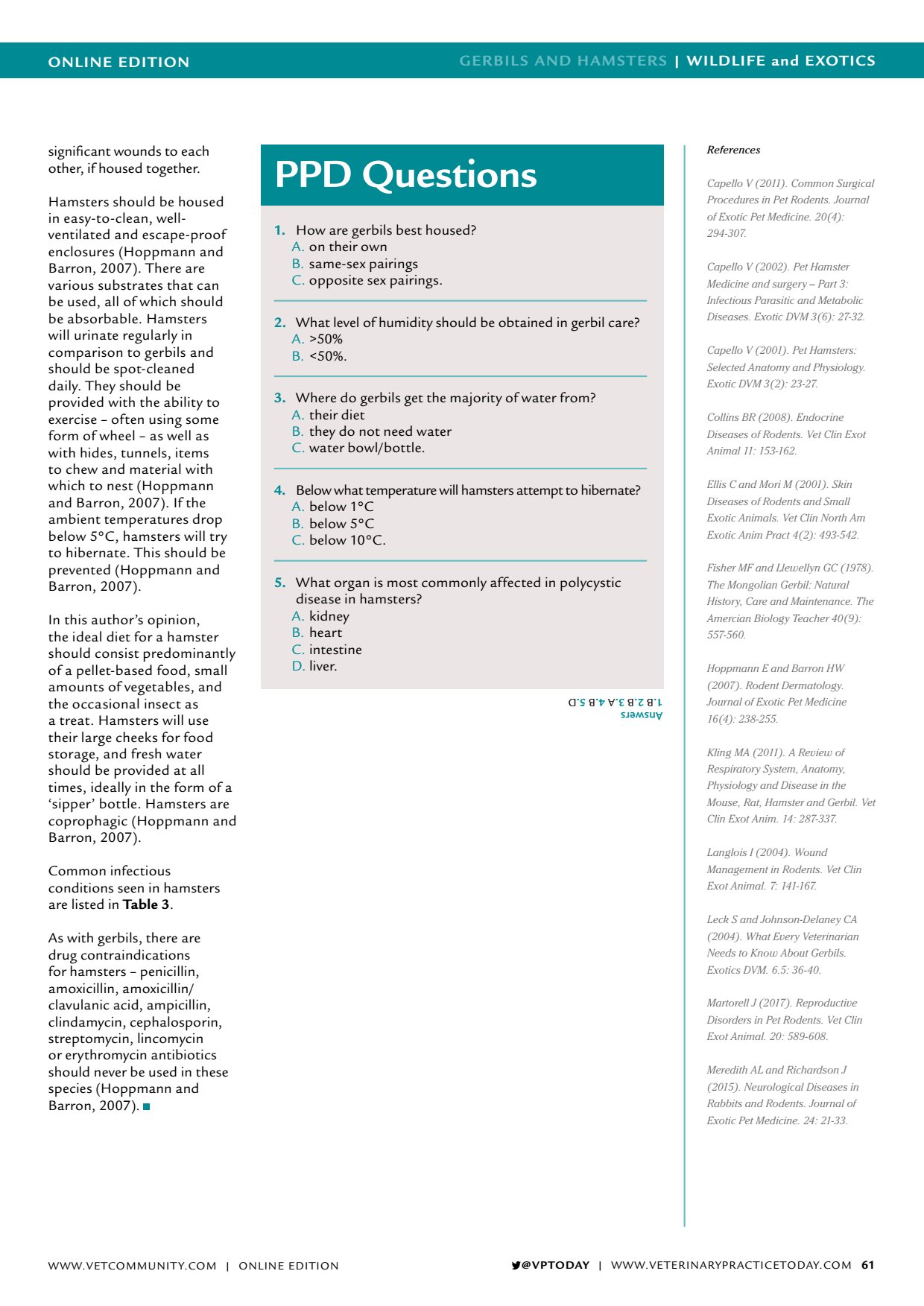Questions ONLINE EDITION
ONLINE EDITION GERBILS AND HAMSTERS | WILDLIFE and EXOTICS VPTODAY | WWW.VETERINARYPRACTICETODAY.COM 61 References Capello V (2011). Common Surgical Procedures in Pet Rodents. Journal of Exotic Pet Medicine. 20(4): 294-307. Capello V (2002). Pet Hamster Medicine and surgery Part 3: Infectious Parasitic and Metabolic Diseases. Exotic DVM 3(6): 27-32. Capello V (2001). Pet Hamsters: Selected Anatomy and Physiology. Exotic DVM 3(2): 23-27. Collins BR (2008). Endocrine Diseases of Rodents. Vet Clin Exot Animal 11: 153-162. Ellis C and Mori M (2001). Skin Diseases of Rodents and Small Exotic Animals. Vet Clin North Am Exotic Anim Pract 4(2): 493-542. Fisher MF and Llewellyn GC (1978). The Mongolian Gerbil: Natural History, Care and Maintenance. The Amercian Biology Teacher 40(9): 557-560. Hoppmann E and Barron HW (2007). Rodent Dermatology. Journal of Exotic Pet Medicine 16(4): 238-255. Kling MA (2011). A Review of Respiratory System, Anatomy, Physiology and Disease in the Mouse, Rat, Hamster and Gerbil. Vet Clin Exot Anim. 14: 287-337. Langlois I (2004). Wound Management in Rodents. Vet Clin Exot Animal. 7: 141-167. Leck S and Johnson-Delaney CA (2004). What Every Veterinarian Needs to Know About Gerbils. Exotics DVM. 6.5: 36-40. Martorell J (2017). Reproductive Disorders in Pet Rodents. Vet Clin Exot Animal. 20: 589-608. Meredith AL and Richardson J (2015). Neurological Diseases in Rabbits and Rodents. Journal of Exotic Pet Medicine. 24: 21-33. Answers 1. B 2. B 3. A 4. B 5. D PPD Questions 1. How are gerbils best housed? A. on their own B. same-sex pairings C. opposite sex pairings. 2. What level of humidity should be obtained in gerbil care? A. >50% B. <50%. 3. Where do gerbils get the majority of water from? A. their diet B. they do not need water C. water bowl/bottle. 4. Below what temperature will hamsters attempt to hibernate? A. below 1C B. below 5C C. below 10C. 5. What organ is most commonly affected in polycystic disease in hamsters? A. kidney B. heart C. intestine D. liver. significant wounds to each other, if housed together. Hamsters should be housed in easy-to-clean, well- ventilated and escape-proof enclosures (Hoppmann and Barron, 2007). There are various substrates that can be used, all of which should be absorbable. Hamsters will urinate regularly in comparison to gerbils and should be spot-cleaned daily. They should be provided with the ability to exercise often using some form of wheel as well as with hides, tunnels, items to chew and material with which to nest (Hoppmann and Barron, 2007). If the ambient temperatures drop below 5C, hamsters will try to hibernate. This should be prevented (Hoppmann and Barron, 2007). In this authors opinion, the ideal diet for a hamster should consist predominantly of a pellet-based food, small amounts of vegetables, and the occasional insect as a treat. Hamsters will use their large cheeks for food storage, and fresh water should be provided at all times, ideally in the form of a sipper bottle. Hamsters are coprophagic (Hoppmann and Barron, 2007). Common infectious conditions seen in hamsters are listed in Table 3 . As with gerbils, there are drug contraindications for hamsters penicillin, amoxicillin, amoxicillin/ clavulanic acid, ampicillin, clindamycin, cephalosporin, streptomycin, lincomycin or erythromycin antibiotics should never be used in these species (Hoppmann and Barron, 2007). WWW.VETCOMMUNIT Y.COM | ONLINE EDITION
